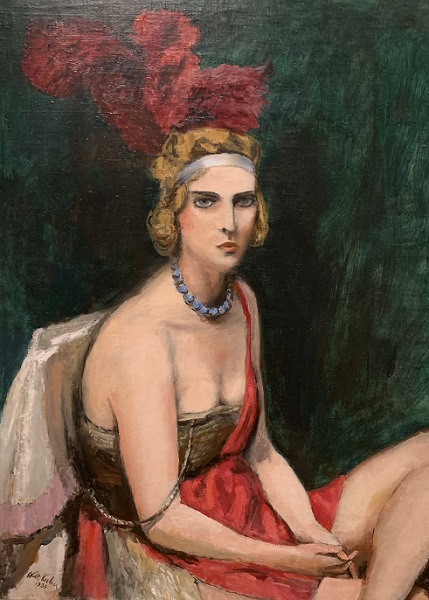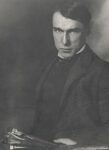
Walt Kuhn
American, 1880-1949
Portrait of Trude, 1930
oil on canvas
48 × 37 in.
SBMA, Gift of Nancy Schlosser
2023.27

Walt Kuhn Holding Palette and Paintbrushes, c. 1904–1905, photograph, Archives of American Art, Smithsonian Institution
RESEARCH PAPER
Walt Kuhn, born William, grew up in Brooklyn, New York. Influenced by his mother’s interest in theatre and his exposure to stage performers, Kuhn would often draw burlesque, vaudeville, and circus performers.
His formal art training started in 1893, where he took art lessons at the Brooklyn Polytechnic Institute. In the years following, Kuhn would earn his living by being a cartoonist in San Francisco for The Wasp, a weekly satirical magazine. In 1901, he continued with his art education in Paris, France at the Académie Colarossi and the Akademie der Bildenden Kunste (Academy of Fine Arts) in Munich. Coming back to Manhattan in 1903, he continued his studies at the Artists’ Sketch Class and painted impressionist landscapes.
Kuhn went on to work as an illustrator, a cartoonist for commercial publications, and producer of circus shows and revues. In 1911 he was one of the founding members of the Association of American Painters and Sculptors (AAPS) with a mission to promote and exhibit modern art. It is from the AAPS that the “Armory Show of 1913” was conceived.
Kuhn was best known as executive secretary of The International Exhibition of Modern Art, commonly known as the “Armory Show” which opened to the public in New York City on February 17, 1913. Although the show was two-thirds American artists, it was the avant-garde works from Europe that caused a stir, according to Marilyn Kushner, co-curator of “The Armory Show at 100” held in October 2013.
American audiences were used to seeing the old masters like Rembrandt and Titian. Upon viewing European artists like Picasso, Matisse, and Duchamp, Kushner said viewers were shocked; they had never seen anything like this unconventional work, and did not know how to relate to it. Terms used to describe the art were “insane” and an “affront to the sensibilities.” In other words, the American public was being exposed to an art revolution; the departure from realistic representation to modernist styles such as cubism, fauvism, and expressionism.
Kuhn’s boyhood interest in circus and stage performers would later be examined as an adult in a number of intimate portraits. “The Portrait of Trude” is such an example. Painted in an impressionistic style, is an expressive Gertrude Lower, a chorus girl in the traveling production of “Show Boat.” She sits with her legs crossed in an immodest position, dressed in a skimpy, revealing costume with one strap falling down her slumped shoulder. The viewer might see her stare-down and feel an impulse to look away. Perhaps the viewer is intruding on her post-performance privacy, and she is thinking, “Hey! What are you looking at? I’m tired! Show’s over!”
The creation of emphasis on the single figure is achieved by using the complimentary colors red and green and contrasting the fair skin tone with the plain emerald green background. The artist’s brushwork to fashion the feather texture on the headdress provides variety compared to the otherwise less texturized areas of the painting. Also, the touch of blue of the necklace adds to the spirit of variety; the work seems more complete with the necklace than without it.
Overall, the brooding Trude is the opposite of what the show audience would have seen in the performance. Through “The Portrait of Trude,” the artist shows a woman of the 1930s impacted by the emotional and physical toll of a life in show business.
The life of Walt Kuhn sadly ended in 1949 in a mental institution where he suffered from declining health, detachment, and confusion.
In his book, “Walt Kuhn, Painter: His Life and Work” by Philip Rhys Adams, the forward flap states, “Few painters have written in such generous and revealing detail of their own work, and few have left behind so voluminous a file of personal correspondence. Mr. Adams draws upon this rich legacy, and upon Kuhn’s incomparable portraits of clowns, showgirls, and acrobats, his unsurpassed still lifes and superb drawings, to trace the personal events and artistic episodes of a life and career inextricably conjoined with the principal developments in the world of art they paralleled.”
BIBLIOGRAPHY
Adams, Philip Rhys. “Walt Kuhn, Painter: His Life and Work.” Ohio State University Press, 1978.
Vitale, Tom. “‘armory Show’ That Shocked America in 1913, Celebrates 100.” “NPR,” NPR, 17 Feb. 2013,
www.npr.org/2013/02/17/172002686/armory-show-that-shocked-america-in-1913-celebrates-100.
“Walt Kuhn.” “Artist Info,”
www.nga.gov/collection/artist-info.1444.html#biography. Accessed 5 Feb. 2024.
COMMENTS
Raised in Brooklyn, Walt Kuhn (born William but called Walt from a young age) developed an early interest in drawing and theater. In 1893 Kuhn took art classes at the Brooklyn Polytechnic Institute. Six years later he was working in San Francisco as a cartoonist for The Wasp, a weekly satirical magazine. Kuhn returned to New York in the fall of 1900, but by March of 1901 he had left again to study art in Europe, first at the Academie Colarossi in Paris and then later that year at the Akademie der Bildenden Künste (Academy of Fine Arts) in Munich. After moving back to Manhattan in the summer of 1903, Kuhn studied at the Artists’ Sketch Class and began painting landscapes in an impressionist style. For the next decade he supported himself as an illustrator and cartoonist for publications including Life and New York World. In 1909 Kuhn married Vera Spier, a jewelry designer who also managed the records of his artistic production.
Through his commercial illustration work Kuhn became acquainted with Robert Henri (American, 1865 - 1929), John Sloan (American, 1871 - 1951), and other progressive artists in their circle. Kuhn assisted Henri and Sloan in organizing the “Exhibition of Independent Artists” in April 1910. The following year Kuhn and a small group of fellow artists founded the Association of American Painters and Sculptors (AAPS), which aimed to promote contemporary artists through non-juried exhibitions. With Arthur B. Davies (American, 1862 - 1928) as its president, the AAPS organized the “International Exhibition of Modern Art”, a major show that included representative works from avant-garde artistic movements in Europe. Serving as the Association’s secretary, Kuhn traveled abroad in 1912 to assist with the selection of European artists. Known as the Armory Show, the exhibition opened in New York on February 17, 1913, and introduced cubism, fauvism, expressionism, and other forms of European modernism to American audiences. Kuhn later recounted the exhibition’s creation and lasting impact in his pamphlet “Twenty-Five Years After: The Story of the Armory Show” (1938). Kuhn continued his work with the AAPS after the Armory Show, which he lamented left him little time for his own work. He also served as an art advisor to prominent American collectors, including John Quinn and Lillie P. Bliss, a founder of the Museum of Modern Art.
Over the next decade, Kuhn experimented with a number of modern styles—including cubism and fauvism—as well as a variety of mediums. In 1925, following a brush with death caused by a duodenal ulcer, Kuhn devoted himself to developing a style of his own. He returned to Europe to study old master paintings and ancient art and minimized his involvement in other activities. By the end of the decade his signature portrait technique had emerged: Kuhn boldly rendered single figures against stark backdrops. His subjects—burlesque and vaudeville performers, circus acrobats, and clowns—reflected his love for the circus and the stage. Despite the colorful costumes and staged poses of his sitters, Kuhn’s portraits are dignified and psychologically probing. The artist also painted many still lifes in a similarly bold, geometric manner.
Kuhn continued to show his art in public exhibitions until 1948. He died in 1949 in White Plains, New York, after being hospitalized following a period of declining health. Throughout his life and following his death, Kuhn’s fame as an organizer of the Armory Show often eclipsed his work as a modernist painter.
- Robert Torchia and Zoë Samels, Walt Kuhn, National Gallery of Art, August 17, 2018
SBMA CURATORIAL LABELS
Kuhn is likely best remembered for his role in the organization of the 1913 Armory Show in New York, which introduced Cubism, Expressionism. and Fauvism to American audiences. Kuhn's art moved firmly in the direction of Picasso and the German Expressionists after that formative experience. He specialized in the depiction of the fringe characters of the entertainment world - stage performers, acrobats and clowns - all subjects that had been expected by the European avant-garde.
This newly gifted painting features one of Kuhn‘s favorite models: Gertrude Lower, a chorus girl in the traveling version of the popular 1927 musical "Show Boat", [with music by Jerome Kern and lyrics by] Oscar Hammerstein. It joins the monumental standing portrait of the same model already in the permanent collection. We know that Kuhn needed the direct contact of the living model to inspire his brush. The standing portrait exudes Trude's unselfconsciousness in her semi nudity, as she confronts us, hands on hips with a look of easy defiance. The seated portrait, by contrast, bristles with the hostility of Trude's unblinking stare. Her performance ended, the artist captures both her fatigue and her resentment at having to entertain by brandishing her eroticized body in such scanty, cheap trappings. The beat of Trude's body and mood radiates from the artist's strategic use of vermillion, as she dares us to look away now that her body is again her own, rather than the spectacle it had been on stage.
- Preston Morton Gallery, 2023
